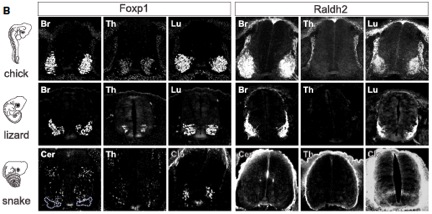June 13 with Joshua Clanton
Evolving Hox Activity Profiles Govern Diversity in Locomotor Systems
Presented by Joshua Clanton, Post Doc (Andrea Page-McCaw Lab)
Jung et al. (2014) Developmental Cell 29(2): 171–187
http://www.sciencedirect.com/science/article/pii/S1534580714001609
 The defining feature of tetrapods is the presence of two sets of paired limbs that allow different modes of locomotion. One of the key innovations that enabled the evolution the tetrapod limb is the formation of the Lateral Motor Column (LMC), a collection of motor neurons that arise from the neural tube to enervate the forming limb. In Jung et al 2014, they show that the formation of the brachial (forelimb) and lumbar (hindlimb) LMCs requires sustained, high levels of Foxp1, which occurs in the absence of Hoxc9 activity. As such, the authors provide an interesting paradigm for the emergence and modification of the tetrapod limb during evolution via shifting Hoxc9 activity along the neural tube.
The defining feature of tetrapods is the presence of two sets of paired limbs that allow different modes of locomotion. One of the key innovations that enabled the evolution the tetrapod limb is the formation of the Lateral Motor Column (LMC), a collection of motor neurons that arise from the neural tube to enervate the forming limb. In Jung et al 2014, they show that the formation of the brachial (forelimb) and lumbar (hindlimb) LMCs requires sustained, high levels of Foxp1, which occurs in the absence of Hoxc9 activity. As such, the authors provide an interesting paradigm for the emergence and modification of the tetrapod limb during evolution via shifting Hoxc9 activity along the neural tube.